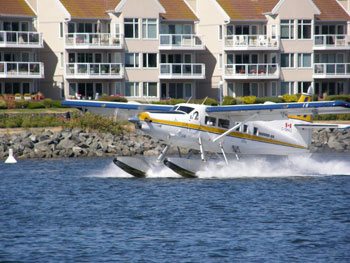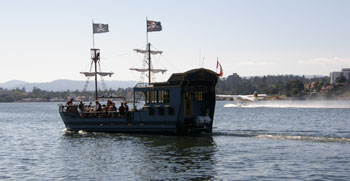Dec
3
By Murray Sinclair
 The Greater Victoria Harbour Authority is looking at assuming responsibility for the city's water airport, now operated by Transport Canada.
The Greater Victoria Harbour Authority is looking at assuming responsibility for the city's water airport, now operated by Transport Canada.
But the president of the James Bay Neighbourhood Association, Marg Gardiner, said the question of whether the GVHA should own and operate the airport doesn't get to the root of the harbour's problems.
She said the dual role of aviation and boating is "superimposing an airport on a very restricted size-wise harbour."
She told the James Bay Beacon that pilots who don't fly into Victoria's harbour are wowed when they learn of the small landing space.
"Sometimes, wingtips can be 50 metres from a residence," said Gardiner.
The GVHA received a letter from Transport Canada in July soliciting the authority's interest in assuming responsibility for the water airport.
On August 16, GVHA's board of directors gave its management team approval to explore this possibility.
"We're going into these discussions cautiously, with our eyes wide open," said Curtis Grad, GVHA's president and CEO, in a press release.
"Management of the water airport is a complex task, with significant responsibilities and material operating costs attached to it."
He added, "it's not a question of 'if' the water airport will be divested by Transport Canada, but 'when', so broad-based regional support and strong leadership will be key to ensuring the 'best deal' for Victoria's harbour."
But Gardiner said the airport part was brought into the harbour long ago without figuring out how the aviation side could fit in with the boating side.
"Thirty-eight years of conflicts are not resolved," the JBNA president said.
Canada's marine act is the parent act of the harbour, Gardiner argued, not the national aeronautics act.
"Transport Canada didn't follow the law of the land" when the airport was brought into the harbour, she said, adding that the city also hasn't followed the rules in zoning properties around the harbour.
"Zoning is contrary to accepted policies in Canada and elsewhere in the world."
Gardiner said the harbour has been governed under draft regulations for 14 years, and "by keeping (the rules) a draft, you can't challenge (them)."
 Calling the GVHA "a very profitable not-for-profit" organization, she said it is not an authority under any legal definition, and only Transport Canada is the port authority.
Calling the GVHA "a very profitable not-for-profit" organization, she said it is not an authority under any legal definition, and only Transport Canada is the port authority.
When asked to respond to Gardiner's views, Grad responded with a statement that outlines what the GVHA is and does.
"Similar to most airport authorities and many local port authorities established across Canada, GVHA was incorporated to facilitate divestiture of federally owned and operated transportation facilities to local operation and control," his statement reads.
"Victoria's water airport is an important piece of the working harbour infrastructure and is critical to the economic health of the community."
Grad's statement clarified that Transport Canada is functioning as both regulator and operator of the Victoria harbour airport.
If the GVHA takes on the role of managing and operating the Victoria Harbour Water Airport, it would "(free) Transport Canada to focus exclusively on its regulatory role."
He added that the GVHA is "accountable to the nine member agencies that created it," including municipal representatives, aboriginal bands, the Greater Victoria Chamber of Commerce, and the Victoria/Esquimalt Harbour Society.
The GVHA will explore transferring ownership from Transport Canada "in collaboration with other key players, such as local municipalities and the Esquimalt and Songhees Nations," Grad promised in a statement.
"As GVHA advances this exploration, community input will play a key role in shaping the future of Victoria Harbour."
